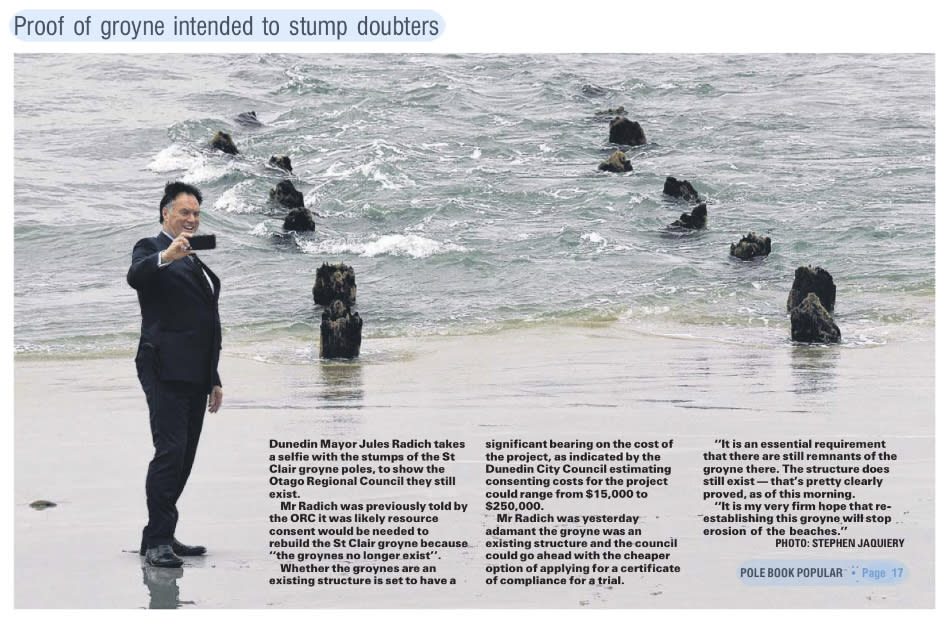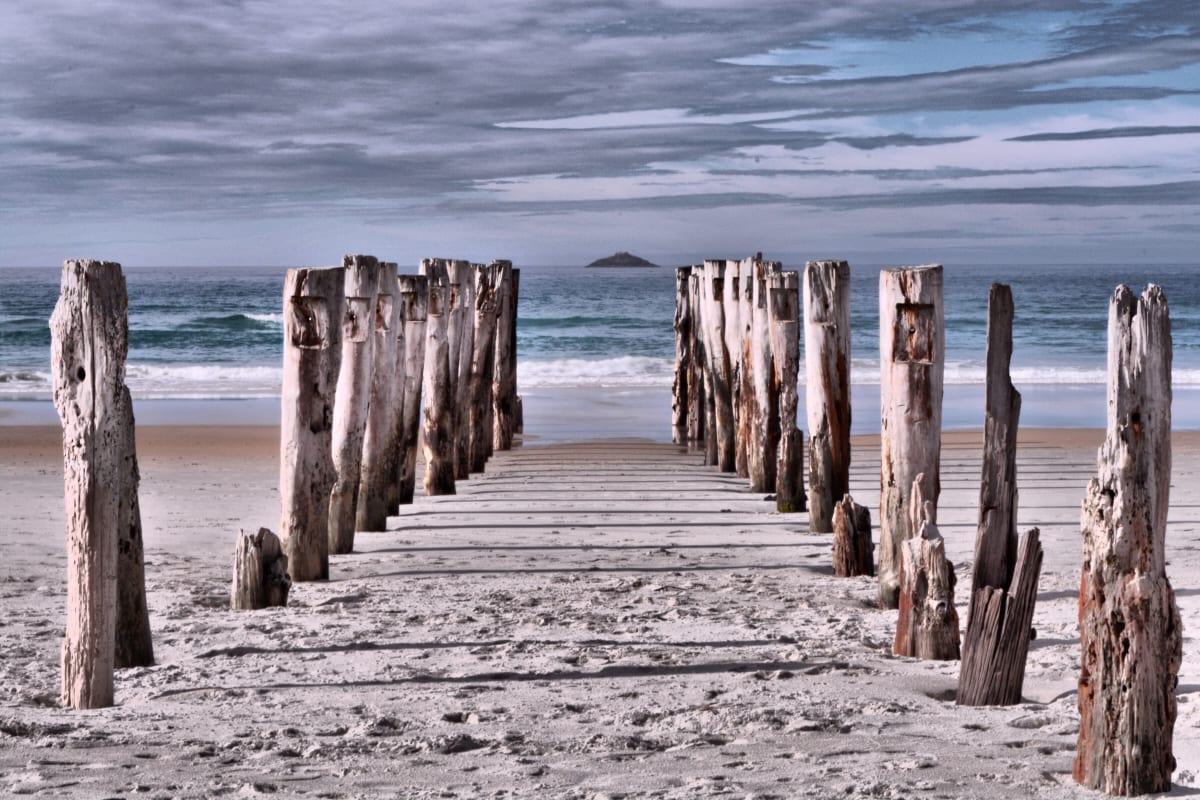
It’s been groyne, groyne, groyne in the southern city since Jules Radich donned the chains of office
It’s enough to make you groan: yet another story in Dunedin’s daily paper about his Groyneship - er, Worship - Jules Radich and his fixation with erecting an anti-erosion pole structure on the city’s St Clair beach.
In the week before Christmas, the Otago Daily Times twice featured the groyne on its front page, made it the subject of an editorial and had other groyne stories on inside pages.
Radich, a St Clair resident and mayor since he ousted Aaron Hawkins in October’s local elections, has been banging on about his groyne for years.
Hawkins, not a member of the groyne fan club, has been keeping a low profile since the election but was spotted in the central city days before Christmas sporting a greying beard that Santa wouldn’t have been ashamed of.
It’s a fair bet the Green former mayor will be dismayed at the attention the groyne’s getting without any reference to the shoreline protection measures contained in the St Clair to St Kilda Coastal Plan (Whakahekerau - Rakiātea Rautaki Tai) that was more than two years in development. In February, Hawkins’ council agreed to adopt the plan, and later in the year gave the thumbs down to the groyne.
The Radich regime has proved more groyne-friendly. In two votes - one taken during a meeting from which the public was excluded - it has backed investigation of the mayor’s pet project.
The Otago Daily Times has dutifully reported every new thrust of the groyne argument, extracting plenty of puns along the way - “Council set to go against the groyne?”, from July 2020, is one of the better ones.
Amusingly, if you’re not watchful when typing “groyne” and “Radich” in the ODT website search engine, the spell checker changes them to groin and radish, as though the paper doesn’t take the subject seriously.
But its coverage says otherwise, December 22’s editorial suggesting the process being followed by the mayor has an air of desperation.

Radich first enthused about his groyne before getting on the council, then when he was elected a councillor in 2019 he stepped up his one-man campaign.
In 2020, the ODT published an opinion piece in which he listed his qualifications for groyne guruhood, including living by the beach, having a dog and a science degree and being a keen student of St Clair groynes down through the ages.
In the lead-up to last year’s council elections, he informed Dunedin ratepayers he’d had a visit from two Dutch coastal engineers - with their dubious creation of an archipelago of sand islands in Dubai, the Dutch can be said to have skills in this area - who endorsed the proposal.
There’s nothing like an overseas expert or two to call upon when the pesky locals don’t fall into line.
In 2017, after Radich, who used to own a motorbike shop and now has property interests and is a business coach, made submissions on his groyne to the Otago Regional and Dunedin City councils, the ODT trotted out coastal geomorphologist Wayne Stephenson who said the proposed pole structure could worsen the effects of sea-level rise.
Stephenson, an associate professor at the University of Otago, again disputed the effectiveness of groynes in June this year as Radich sought to convince the Hawkins-led council to agree to a five-year trial, which it rejected.
Going for groyne
Now he’s in charge, it’s all on again. Except the experts, for the most part, remain unconvinced, and the mayor’s belief that a resource consent - at a possible cost of up to $250,000 - isn’t required because he proposes rebuilding an existing structure also looks shaky.
The regional council has apparently determined there is no structure left and has told the mayor so, but the ODT reports him saying “there’s far more of the structure available for us to repair than what might be imagined”.
The proof was on December 22’s front page, which featured the mayor taking a selfie on St Clair beach with a double row of ex-groyne stumps leading into the water behind him.
The groyne-effectiveness argument centres on which direction St Clair’s shifting sands are going. Radich believes the movement is along the beach, and his proposed barrier of poles and planks based on early 20th Century drawings is designed to block the flow.
He places great store by his observation that the most recent structure, rebuilt in 1955 and the last pole of which was washed away in July, worked for as long as it was intact.
“Thereafter, St Clair enjoyed another 50 years of deep sand and a wide beach thanks to a few simple poles with strong boards between them, which quickly became buried by the sand they accumulated,” he wrote in his ODT opinion piece. The proof, he said, is in photos from 1969 and 1989.

More recent observations during visits to the beach over the past winter suggest shoreline erosion is happening apace, with successive southerly storms eating further into the dunes between the sea and South Dunedin.
At full blast, the wind sends waves crashing into the sea wall protecting the Esplanade Restaurant south of the beach with such force that the concussion can be felt at the tables inside (where, incidentally, Radich was heard days after being elected mayor telling the proprietor a groyne was one of his priorities - whoever said anything about due process).
A week or two later, when he put a motion to the new council that it request an urgent report on the cost and time frame for reinstating the groyne, “potentially on a trial basis”, it was passed by a substantial majority.
Lee Vandervis, a six-term councillor who has waged a one-man war on city debt and reflexively opposes spending on such civic amenities as public sculpture and rainbow street crossings, supported the groyne trial despite its potential $570,000 cost and having been put in charge of the finance and council-controlled organisations committee, to say nothing of the gamble on its usefulness.
On the day of the vote, the ODT quoted another university specialist on sand movement.
Associate professor Mike Hilton said a combination of the direction in which St Clair’s sand naturally goes, the power of the waves and the location of the Esplanade sea wall would make a groyne ineffective.
They work on certain kinds of coast, but not Dunedin’s, he said.
On the other hand, if the poles were replaced for aesthetic reasons - he acknowledged they’d often featured in paintings, photographs and postcards - “I have some sympathy”.
If there’s doubt about a groyne’s worth as a cure for St Clair’s beach erosion, there’s no question of its fund-raising value.
A book has been compiled of publicly provided photos of the poles before they were all washed away with $20 from each copy sold going to the local surf life saving club.
The ODT reports $10,000 had been collected before Christmas.
Made with the support of the Public Interest Journalism Fund








